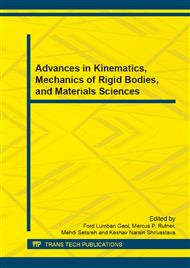p.53
p.63
p.69
p.75
p.83
p.93
p.105
p.111
p.117
A Model-Inspired Phenomenology Constitutive Equation for the Temperature-Dependence of Flow Stress at Confined Dimension I
Abstract:
A model-inspired phenomenology constitutive equation was developed from the first principles to study the temperature dependence of flow stress at confined dimension. The model was limited in the range of temperature and strain-rate where diffusion is insignificant. It was assumed that flow stress was predominantly governed by the thermal activation of dislocation lines overcoming short-range barriers. A simple sound model was developed from the established principles. Data from relevant experiments were fitted into the model to evaluate and reveal key parameters. Normalization of the data and linearization of the model were performed prior to the evaluation and analysis. The proposed models were generally well fitted to the experimental data as indicated by the correlation factors of >0.85, which could be principally accepted by the criteria of R2=0.90. Of the candidate models, Model III and Model I are particularly recommended to study the temperature-dependent behavior of Cu at confined dimension in the space of interest related to the intended applications (2<TM/T<5). Physical mechanistic re-interpretation of the models for the problem of interest is presented in the second report (Part II).
Info:
Periodical:
Pages:
83-92
Citation:
Online since:
February 2014
Authors:
Keywords:
Price:
Сopyright:
© 2014 Trans Tech Publications Ltd. All Rights Reserved
Share:
Citation:


